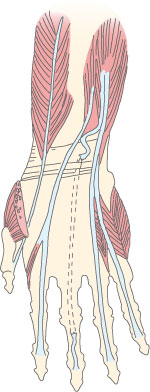Definition and cause of tendon injuries and tendon ruptures.

The tendons attach to the muscles.
When a tendon is cut or torn,
the muscle pulls together,
pulling the tendon ends away from
each other.A surgeon will often locate
the tendon ends and
sew them together again.
Muscles from the forearm and lower leg manage the function of hands and feet. These muscles end up in long strong tendons, which run past the wrist and ankle joints and attach on the hand or the fingers, respectively the feet and toes. Via the tendons the muscles manage the movement of the respective limbs.
Unfortunate injuries or cuts in these areas might in part or in total cut a tendon. Aside from the wound being serious and possibly damage other structures, a total severance of a tendon (tendon rupture) will result in the loss of the tendon function.
Continued use of a partially severed tendon might result in a full tendon rupture.
Symptoms of tendon injury
It is very clear for the individual, if a tendon has burst. There will be pain and immediate loss of function, For example it may be impossible to bend or stretch a finger fully. The muscle that pulls the affected tendon will contract as there is no longer any opposite pull and the muscle will bulge. If it is a rupture affecting the large upper arm muscle (biceps) the muscle will resemble a Popeye arm.
Besides pain, a partially severed tendon will result in reduced muscle function. In some cases involving strong tendons the tendon might pull a piece of bone tissue from where it attaches to the bone. The tendon is intact but a fracture has occurred and the tendon function is eliminated.
Treatment of tendon injuries
The diagnosis made by a physician or in an emergency room is relatively simple. Tendon damage will often be accompanied by an open wound and it will often be possible to see a part of the severed tendon in the wound. In cases of tendon rupture with lost function the possibility of a fracture at the attachment point must be examined and excluded if there are no cuts before the diagnosis of tendon rupture is made.
If a tendon is completely rupture the treatment in most cases will be to sew the tendon ends together which involves a bigger or smaller operation depending on the size of the tendon followed by immobilization in a cast to eliminate pull on the tendon during the healing process
A partially severed tendon, and a few total ruptures, may be treated with immobilization only with a cast in cases where the tendon ends can be positioned so that they have contact with each other and are able to grow together again. However, it might be necessary to sew together also partially severed tendons.
Healing is a lengthy process, because tendon tissue grows slowly.
Outlook and complications.
Most partially cut, or ruptured, tendons grow together easily. However, healing takes a long time and if the immobilization is stopped too early there is a risk that the injury breaks up. It may happen that a damaged tendon can lead to subsequent stiffness and loss of movement as for example a finger.
Læs denne artikel på dansk |